It’s a bold move for any contemporary choreographer to reimagine Bronislava Nijinska and Igor Stravinsky’s modernist ballet Les Noces, an apogee of Ballets Russes avant-gardism. Colette Sadler employs big wigs, black crochet bodysuits and some thumping bass for her version, Ritualia (★★★☆☆), and dispenses with the Russian peasant wedding in favour of a more gender-fluid festivity. The body itself appears to be the source of celebration, but a frustrating sense of superficiality prevails.
In the original ballet, separate huddles of men and women submit to collective custom with grim blankness. Sadler’s dancers, however, exude the expressionless insouciance of catwalk models. Ritualia is all androgyny, with snappily splayed, corrugated limbs and undulating ensemble work.

Later, hints of voguing emerge but the struts aren’t animated by joyful energy or combative ferocity. Yet the dancers navigate Stravinsky’s serrated rhythms with confidence and there are arresting sequences, such as a sidestepping male duet – both brawny and delicate – that has the dancers looped and linked at the forearms.
While Les Noces uses the bride’s long plaits as a symbol of femininity and fecundity, here a large pile of blonde braided hair becomes something to wear, like a ropey take on Lady Gaga’s meat dress. It’s visually striking to begin with, but there’s not much beyond the pose.
An ominous mass of brown hair lies downstage in Sadler’s Learning from the Future (★★☆☆☆), in which a solo, shaven-headed dancer (Leah Marojevic) portrays a female cyborg in a metallic bodysuit. Aside from the hairy evidence of pre-robot life, there’s only a video screen that contrasts flashing images of human artefacts like pottery and statues with disconnected chunks of computerised cyborg design.
Brendan Dougherty’s electronic score provides an oppressively churning accompaniment to Marojevic’s mechanised motion, the jerkiness of which is enhanced by heavy bouts of strobe lighting. Luckily, cyborgs don’t get migraines. Although Marojevic gives an accomplished performance – spinning and sweeping her robo-limbs, bending and balancing at odd angles, sometimes shuddering like she might be on the verge of a malfunction – it’s unclear what Sadler’s dancing bionic creation is saying about AI. It doesn’t really come to life.
Ritualia is at Zoo Southside, Edinburgh, until 24 August. Learning from the Future is at Dance Base, Edinburgh, until 24 August.

Comments (…)
Sign in or create your Guardian account to join the discussion